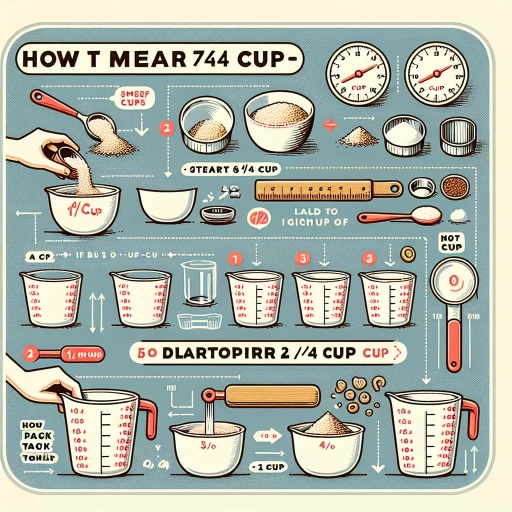How To Make 3/4 Cup

Understanding Cup Measurements in Baking
Importance of Accuracy in Measurements
When it comes to baking, precision is key. The accuracy of measurements influences the consistency, texture, and flavor of the final product. For example, if you use too much baking soda, the finished item could taste bitter and have a soapy aftertaste. Likewise, incorrect proportions of liquid ingredients can change the texture and consistency of the dough or batter, leading to a disappointing outcome. That's why knowing how to measure correctly, including knowing how to make 3/4 cup, is crucial when baking.
Common Measuring Tools in Baking
There are numerous measuring tools available to aid in baking. For dry ingredients such as flour, sugar, and leavening agents, we typically use measuring spoons and cups. Liquid ingredients like water, milk, or syrup are typically measured in glass or plastic jugs with markings. When it comes to making 3/4 cup of an ingredient, using the right tools can make a significant difference. For example, a set of measuring cups usually includes a 1-cup, 1/2-cup, 1/3-cup, and 1/4-cup measurements, allowing you to accurately make a 3/4 cup measurement.
Difference Between Liquid and Dry Measurements
It's also essential to draw a distinction between liquid and dry measurements when baking. While they may seem interchangeable, using a dry measuring cup for a liquid, or vice versa, can result in inaccurate measurements. A liquid measuring cup lets you fill the ingredient up to the desired measurement line, ensuring an accurate volume. A dry measuring cup, on the other hand, is meant to be filled to the top and then leveled off for an accurate measure. This understanding is essential when you're trying to make 3/4 cup of an ingredient.
Step-by-Step Guide to Make 3/4 Cup
Using Measuring Cups
One way of making 3/4 cup is with standard measuring cups. In most cases, a set will include 1/4, 1/3, 1/2, and 1-cup measurements. To make 3/4 cup, simply fill the 1/2-cup one time and the 1/4-cup one time. Combine these two and you have 3/4 cup of your ingredient. Remember to level off dry ingredients for accuracy.
Using a 1-Cup Measure
If you don't have a set of measuring cups, but you do have a 1-cup measure, this method is for you. To make 3/4 cup, you'll have to eyeball it. Fill the 1-cup measure to what looks like 3/4 of the way up. It might be helpful to use a ruler or a scale for more accuracy. This method requires more guesswork, so it might not be as precise as using multiple measuring cups.
Using Tablespoons
Another method for making 3/4 cup is by using tablespoons. There are 16 tablespoons in 1 cup, so 3/4 cup would equal 12 tablespoons. It means you would need to fill a tablespoon measurement 12 times to make 3/4 cup. While this method might be more time-consuming, it can be more accurate, especially if you don't have a 1/4 or 1/2 cup measure.
Tips and Tricks for Accurate Measuring
Weight vs. Volume
Sometimes, the weight of the ingredient can be more accurate in baking than the volume. Items like flour and sugar can be compacted or aerated, leading to inconsistent volume measurements. Weighing ingredients using a kitchen scale provides greater accuracy. However, if you're still required to measure using volume, like making 3/4 cup, ensure to spoon the ingredient into the measuring cup and level off with a knife to avoid compacting.
Handling Liquid Ingredients
When measuring liquid ingredients, make sure to set the measure on a flat surface and read the measurement at eye level. This helps to avoid any over or under-pouring of liquid ingredients, ensuring you get an accurate 3/4 cup.
Correctly Measuring Ingredients like Brown Sugar or Shortening
For ingredients like brown sugar or shortening that can be compacted, the correct way to measure is to pack them into the measuring cup. When the recipe calls for 3/4 cup of such ingredients, ensure the cup is packed, and the ingredient is level with the top of the measure to get an accurate measurement.